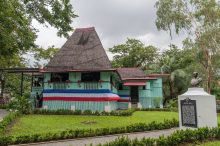Museo ni Apolinario Mabini, PUP, the Philippines

 The Mabini Shrine bamboo and nipa house, currently located within the campus of the Polytechnic University of the Philippines (PUP), belonged to the del Rosario family to whom Filipino hero Apolinario Mabini was related by affinity. (His younger brother married a del Rosario daughter.) Mabini first lived in this house in 1888, the year he entered law school. He continued to live there during most of his adult years. The original house used to be located across the Pasig River. It was moved to PUP in Sta. Mesa, Manila, in 2009 to give way to the widening of the Pasig River.
Important artifacts on display are Mabini’s original photograph, a wooden wreath bequeathed by a friend from Paete, Laguna, a long wooden bench used by the Mabini family; and paintings from the 1964 Apolinario Mabini Birth Centennial painting competition. Reproductions of his convalescent chair and escritoire are prominently displayed at the "sala".
Accompanying the nipa house is the Museo ni Apolinario Mabini, which chronicles the life of the “Revolution’s philosopher” in a fun and interactive manner. Various interactive exhibits can be seen inside the museum, including a touch screen terminal featuring Mabini’s life, as well as an electronic board which allows guests to jot down experiences from their visit. With the theme “Duyan”, visitors can reflect on Mabini’s heroism and strength, while sitting on a hammock and inviting contemplation on the sage words of his writings.
The various galleries in the Museo ni Apolinario Mabini follow a thematic approach. Sections are named after an item/object related to Mabini’s character, serving as a metaphor to his life and contributions:
The Mabini Shrine bamboo and nipa house, currently located within the campus of the Polytechnic University of the Philippines (PUP), belonged to the del Rosario family to whom Filipino hero Apolinario Mabini was related by affinity. (His younger brother married a del Rosario daughter.) Mabini first lived in this house in 1888, the year he entered law school. He continued to live there during most of his adult years. The original house used to be located across the Pasig River. It was moved to PUP in Sta. Mesa, Manila, in 2009 to give way to the widening of the Pasig River.
Important artifacts on display are Mabini’s original photograph, a wooden wreath bequeathed by a friend from Paete, Laguna, a long wooden bench used by the Mabini family; and paintings from the 1964 Apolinario Mabini Birth Centennial painting competition. Reproductions of his convalescent chair and escritoire are prominently displayed at the "sala".
Accompanying the nipa house is the Museo ni Apolinario Mabini, which chronicles the life of the “Revolution’s philosopher” in a fun and interactive manner. Various interactive exhibits can be seen inside the museum, including a touch screen terminal featuring Mabini’s life, as well as an electronic board which allows guests to jot down experiences from their visit. With the theme “Duyan”, visitors can reflect on Mabini’s heroism and strength, while sitting on a hammock and inviting contemplation on the sage words of his writings.
The various galleries in the Museo ni Apolinario Mabini follow a thematic approach. Sections are named after an item/object related to Mabini’s character, serving as a metaphor to his life and contributions:
- 1. Timeline of Apolinario Mabini’s Life: Events in the life of Apolinario Mabini are exhibited on the walls of the museum and also displayed on a touchscreen terminal. His education, profession, and role in the Revolution are among its highlights.
- 2. Duyan (Hammock): The hammock is a symbol of Apolinario Mabini’s role in the struggle for freedom and sovereignty of the Filipino nation. Mabini, who became paralyzed in 1896, did not let his disability stop him from achieving greatness. Despite facing continuous struggles, he urged Filipinos to aspire for excellence.
- 3. Abaka (Abaca): Through his leadership and intellect, Mabini bound the people toward a single aspiration and purpose: the freedom of the Motherland. The abaca that binds the hammock and bamboo symbolizes the strength and determination of Mabini.
- 4. Kawayan (Bamboo): The bamboo is known to be tough and durable – similar to Mabini’s personal code. Resolute in his principles, the Americans labeled Mabini ‘intransigent’—a noble appellation for one who loved his country.
- 5. Ratan (Rattan): Rattan strips are sturdy materials used to fasten and piece objects together. In the time of conflict, against the enemies as well as within themselves, Mabini bound the Filipinos together through nationalist ideas taught in his work, El Verdadero Decalogo.
- 6. Taga-pasan (Bearer): It is the government that bears the people’s aspirations and burdens. Mabini outlined a stable government which consisted of the executive, legislative, and judicial branches which, according to him, will serve as the society’s will for action, intellect in guidance, and conscience in punishing the guilty.
- 7. Silid Stereoscopy (Stereoscopy Room): The Stereoscopy Room allows visitors to view 19th century photographs on the Philippines using a stereoscopic viewer. These stereoscopic photographs create three-dimensional images by juxtaposing two similar scenes using special lenses. These photographs became popular among foreigners because it allowed them to view exotic images of the Orient.
- 8. Si Mabini at ang Digmaang Pilipino- Amerikano 1899-1903 (Mabini and the Philippine-American War 1899-1903): Freedom from Spain was short-lived owing to the American occupation of the Philippines. Mabini refused to accept the imperialist agenda of the United States, for which reason he was exiled to Guam. In his earnest desire for the liberation of the country, Mabini sacrificed his own freedom.
- 9. Mga Pamana ni Mabini (Legacies of Mabini): Various monuments, landmarks, buildings, schools, streets, as well as commemorative stamps, medallions, etc. dedicated to Mabini are displayed on this area. This is also where the visitors can jot down their museum visit thru the electronic board.
View all Asia-Europe Museum Network (ASEMUS) members in the Philippines
Similar content
07 Dec 2017
